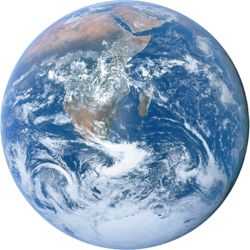The natural and conservation
Matters are complicated by the fact that the worlds nature and natural have more than one meaning. On the one hand there is the main dictionary meaning for nature: "The phenomena of the physical world collectively, including plants, animals, the landscape, and other features and products of the earth, as opposed to humans or human creations." [15] On the other hand, there is the growing awareness, especially since Charles Darwin, of humanities biological affinity with nature. [16]
The dualism of the first definition has its roots is an "ancient concept", because early people viewed "nature, or the nonhuman world […] as a divine brother, godlike in its separation from humans." [17] In the West, Christianity's myth of the fall, that is the expulsion of humankind from the Garden of Eden, where all creation lived in harmony, into an imperfect world, has been the major influence. [18] Cartesian dualism, from the seventeenth century on, further reinforced this dualistic thinking about nature. [19] With this dualism goes value judgement as to the superiority of the natural over the artificial. Modern science, however, is moving towards a holistic view of naturetion. [20]
America
What is meant by natural, within the American conservation movement, has been changing over the last century and a half.
In the mid-nineteenth century American began to realize that the land was becoming more and more domesticated and wildlife was disappearing. This led to the creation of American National Parks and other conservation sites. [21] Initially it was believed that all that was needed to do was to separate what was seen as natural landscape and "avoid disturbances such as logging, grazing, fire and insect outbreaks." [22] This, and subsequent environmental policy, until recently, was influenced by ideas of the wilderness. [23] However, this policy was not consistently applied, and in Yellowstone Park, to take one example, the existing ecology was altered, firstly by the exclusion of Native Americans and later with the virtual extermination of the wolf population. [24]
A century later, in the mid-twentieth century, it began to be believed that the earlier policy of "protection from disturbance was inadequate to preserve park values", and that is that direct human intervention was necessary to restore the landscape of National Parks to its ‘'natural'’ condition. [22] In 1963 the Leopold Report argued that "A national park should represent a vignette of primitive America". [25] This policy change eventually led to the restoration of wolves in Yellowstone Park in the 1990s.
However, recent research in various disciplines indicates that a pristine natural or "primitive" landscape is a myth, and it now realised that people have been changing the natural into a cultural landscape for a long while, and that there are few places untouched in some way from human influence. [26] The earlier conservation policies were now seen as cultural interventions. The idea of what is natural and what artificial or cultural, and how to maintain the natural elements in a landscape, has been further complicated by the discovery of global warming and how it is changing natural landscapes. [27]
Also important is a reaction recently amongst scholars against dualistic thinking about nature and culture. Maria Kaika comments: "Nowadays, we are beginning to see nature and culture as intertwined once again – not ontologically separated anymore […].What I used to perceive as a compartmentalized world, consisting of neatly and tightly sealed, autonomous 'space envelopes' (the home, the city, and nature) was, in fact, a messy socio-spatial continuum". [28] And William Cronon argues against the idea of wilderness because it "involves a dualistic vision in which the human is entirely outside the natural" [29] and affirms that "wildness (as opposed to wilderness) can be found anywhere" even "in the cracks of a Manhattan sidewalk." [30] According to Cronon we have to "abandon the dualism that sees the tree in the garden as artificial […] and the tree in the wilderness as natural […] Both in some ultimate sense are wild." [30] Here he bends somewhat the regular dictionary meaning of wild, to emphasise that nothing natural, even in a garden, is fully under human control.
Europe
The landscape of Europe has considerably altered by people and even in an area, like the Cairngorm Mountains of Scotland, with a low population density, only " the high summits of the Cairngorm Mountains, consist entirely of natural elements. [31] These high summits are of course only part of the Cairngorms, and there are no longer wolves, bears, wild boar or lynx in Scotland's wilderness. [32] [33] [34] The Scots pine in the form of the Caledonian forest also covered much more of the Scottish landscape than today. [35]
The Swiss National Park, however, represent a more natural landscape. It was founded in 1914, and is one of the earliest national parks in Europe. Visitors are not allowed to leave the motor road, or paths through the park, make fire or camp. The only building within the park is Chamanna Cluozza, mountain hut. It is also forbidden to disturb the animals or the plants, or to take home anything found in the park. Dogs are not allowed. Due to these strict rules, the Swiss National Park is the only park in the Alps who has been categorized by the IUCN as a strict nature reserve, which is the highest protection level. [36]


